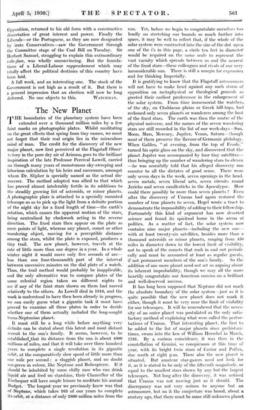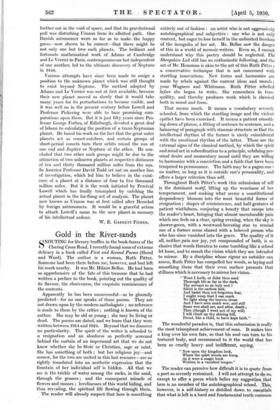The New Planet
THE boundaries of the planetary system have been extended over a thousand million miles by a few faint marks on photographic plates. Whilst meditating on the great effects that spring from tiny causes, we must not forget that their real origin lies in the miraculous mind of man. The credit for the discovery of the new major planet, now first perceived at the Flagstaff Obser vc_tory in the pure dry air of Arizona, goes to the brilliant inspiration of the late Professor Percival Lowell, carried on through many years of monotonous sky-sweeping and laborious calculation by his heirs and successors, amongst vvhom.Dr. Slipher is specially named as the actual dis- coverer. The method adopted was allied to that which has proved almost intolerably fertile in its additions to the steadily growing list of asteroids, or minor planets. A photographic plate is attached to a specially mounted telescope so as to pick up the light from a definite portion of the night sky for a fixed length of time—the earth's rotation, which causes the apparent motion of the stars, being neutralised by clockwork acting in the reverse direction. The fixed stars then appear on the plate as mere points of light, whereas any planet, comet or other wandering object, moving for a perceptible distance among the stars, whilst the plate is exposed, produces a tiny trail. The new planet, however, travels at the rate of little more than one degree in a year. In a whole winter night it would move only five seconds of arc— less than one four-thousandth part of the interval between successive minutes on the dial plate of a watch. Thus, the trail method would probably be inapplicable, and the only alternative was. to compare plates of the same celestial region taken on different nights to see if any of the faint stars shown on them had moved relatively to the others. As Lowell died in 1916, and the work is understood to have then been already in progress, we can easily guess what a gigantic task it must have proved to examine all these plates in order to decide whether one of them actually included the long-sought trans-Neptunian planet.
It must still be a long while before anything very definite can be stated about this latest and most distant recruit to the sun's family. It seems, however, to be establisheda`that its distance from the sun is about 4000 millions of miles, and that it will take over three hundred years to complete a single revolution in its gigantic orbit, at the comparatively slow speed of little more than one -mile per second : a- sluggish planet, and no doubt sea-green in colour, like Neptune and Robespierre. If it should be inhabited by some chilly race who can drink liquid air and feed on•starshine,- their Chancellor of the Exchequer will have ample leisure to meditate his annual Budget The longest year we previously-knew was that 'Neptune, which' takes -165 of our years to complete its orbit, at &distance of only 2800 million miles from the sun. Yet, before we begin to congratulate ourselves too loudly on stretching- our bounds so much further into space, it may be well to reflect that, if the whole of the Solar system were contracted into the size of the dot upon one of the i's in this page, a circle ten feet in diameter would be required on the same scale to represent the vast vacuity -Which spreads between us and the nearest of-the fixed- stars—these colleagues and rivals of our very inconsiderable sun. There is still a margin for expansion and for thinking Imperially.
It is gratifying to know that the Flagstaff astronomers will not have to make head against any such storm of opposition on metaphysical or theological grounds as greeted their earliest predecessor in the enlargement of the solar system. From time immemorial- the watchers of the sky,- on Chaldaean plains or Greek hill-tops, had reckoned only seven planets or wanderers among the host of the fixed stars. The earth was then the centre of the physical universe, and the names of the seven wandering stars are still recorded in the list of our week-days—Sun, Moon, Mars, Mercury, Jupiter, Venus, Saturn—though most of them preserve the flavour of Germanic philology. When Galileo, " at evening, from the top of Fesole," turned his optic glass on the sky, and discovered that the planet Jupiter was accompanied by four tiny satellites— thus bringing up the number of wandering stars to eleven —he was scornfully told that his alleged discovery ran counter to all the dictates of good sense. There were only seven days in the week, seven openings in the head, seven metalS, seven liberal arts, seven circuits round Jericho and seven candlesticks in the Apocalypse. How could there possibly be more than seven planets ? Even after the discovery of Uranus had again restored the number of true planets to seven, Hegel wrote a tract to demonstrate the impossibility of adding to their fellowship. Fortunately this kind of argument has now deserted science and found its spiritual home in the arena of politics. As a matter of fact, the solar system now contains nine major planets—including the new one— with at least twenty-six satellites, besides more than a thousand asteroids or minor planets, ranging from 450 miles in diameter down to the lowest limit of visibility, not to speak Of the. comets that rush in and out periodi- cally and must be accounted at least as regular guests, if not permanent members of the sun's family. So the addition Of One more planet need not set us arguing about its inherent improbability, though we may all the more heartily congratulate our' American cousins on a brilliant and well-deserved success.
It has long been supposed that Neptune did not mark the absolute boundary of the solar system—Just as it is quite possible that the new planet does not mark it either, though it must be very near the limit of visibility for our telescopes. It will be remembered that the neces- sity of an outer planet was postulated as the only satis- factory method of explaining what were called the pertur- bations of Uranus. That interesting planet, the first to be added to' the list of .major planets since prehistcirie times, swam into the ken of William Herschel in March, 1781. By a curious coincidence, it was then in the constellation of Gemini, so conspicuous at this time of year, with its bright twin stars of Castor and Pollux, due south at eight p.m. There also the new planet is situated. But amateur' star-gazers need not look for it, as it is stated to be only of the fifteenth magnitude, or equal to the smallest stars shown by any but the largest telescopes. Not long after the discovery, it was noticed that Uranus was not moving just as it should. The discrepancy was not very serious to anyone but an astronomer, but on it the conjecture was. based, about a century ago, that there must be some still unknown planet further out in the void of space, and that its gravitational pull was disturbing Uranus from its allotted path. One Danish astronomer went so far as to make the happy guess—now shown to be correct—that there might be not only one but two such , planets. The brilliant and fortunate mathematical work of Adams at Cambridge and Le Verrier in Paris, contemporaneous but independent of one another, led to, the ultimate discovery of Neptune in 1846.
Various attempts have since been made to assign a position to the unknown planet which was still thought to exist beyond Neptune. The method adopted by Adams and Le Verrier was not at first available, because their new planet moved so slowly that it would take many years for its perturbations to become visible, and it was well on in the present century before Lowell. and Professor Pickering were able to base promising com- putations upon them. But it is just fifty years since Pro- fessor George Forbes, of Edinburgh, devoted a great deal of labour to calculating the position of a trans-Neptunian planet. He based his work on the fact that the great outer planets act as comet-catchers, and certain groups of short-period comets turn their orbits round the sun at one end and Jupiter or Neptune at the other. He con- cluded that two other such groups might be due to the attraction of two unknown planets at respective distances of ten and thirty thousand million miles from the sun.. In America Professor David Todd set out on another line. of investigation, which led him to believe in the exist- ence of a planet at a distance of four to five thousand million miles. But it is the work initiated by Percival Lowell which has finally triumphed by catching the, actual planet in the far-flung net of analysis. The planet now known as Uranus was at first called after Herschel by foreign, astronomers. It would be a graceful action to attach Lowell's name to the new planet in memory of his intellectual ardour. IV. E. dARRETT FISHER.











































 Previous page
Previous page